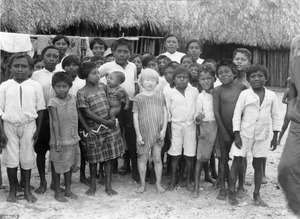White Amazonian Indians facts for kids
"White Amazonian Indians" or "White Indians" is a name given to people with lighter skin living in the Amazon rainforest. Stories about these mysterious white-skinned people began in the 1500s. Spanish missionaries first reported seeing them. These tales even inspired explorer Percy Fawcett to search for a lost city in the Amazon. Over time, many ideas have been suggested about who these "White Indians" might be.
Contents
History of Sightings
The first person to claim seeing a white tribe was a Spanish missionary named Gaspar de Carvajal. In 1542, he wrote about a tribe of Amazonian women. He described them as "very white and tall" with "long hair, braided and wound about their heads." A British journalist, Harold T. Wilkins, later collected more stories. His 1945 book, Mysteries of Ancient South America, included accounts of "White Indians" from the 1500s to the 1800s. These stories came from explorers and Jesuits.
In the 1920s, Percy Fawcett searched for the Lost City of Z in the Amazon. He believed this city was home to a group of "White Indians."
Another expedition in 1924-1925 was led by Alexander Hamilton Rice, Jr.. This trip explored parts of the Amazon near the Parima River. The New York Times reported on this expedition in 1925. The article described an encounter with "White Indians." It said two Indians, "bleached white by the sun," came out of the forest. Dr. Rice described them as small and thin. Their faces had paint, making it hard to see their features. But they were "undeniably white." They wore no clothes and carried bows and arrows with poison tips. When they received gifts, more people joined them, making a group of twenty men and two women.
Groups Thought to Be "White Indians"
Some groups of Native Americans have features that led people to call them "White Indians."
Parakanã Indians
The Brazilian Parakanã are one group that might be linked to these stories. While some Parakanã have lighter skin, their skin color is similar to other Native American groups. Studies show no evidence that they mixed with Caucasians (people of European descent).
Aché Indians
The Aché (pronounced ah-CHAY) Indians are a traditional tribe from Paraguay. They are hunter-gatherers, meaning they find their food by hunting and gathering plants. Early descriptions of the Aché often mentioned their light skin, light eyes, and light hair. They were also noted for having heavy beards and features similar to people from Asia.
Some writers thought the Aché might be descendants of Vikings or European sailors whose ships crashed. However, neighboring groups said the Aché looked more like Japanese people, not Europeans. A study in 1996 found that the Aché are physically and genetically different from most other South American Indians. But the study also confirmed they have no European or African genes mixed in.
Guna of Panama
The Guna people live in Panama and Colombia. They have a high number of people with albinism. Albinism is a condition where a person has very little or no color in their skin, hair, and eyes. Because of this, Westerners in the early 1900s nicknamed them "white Indians."


